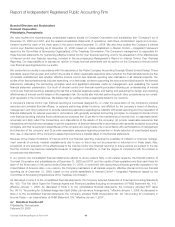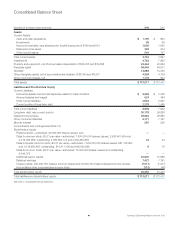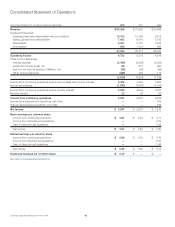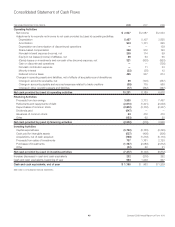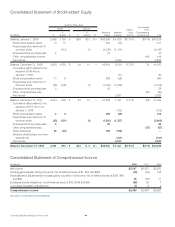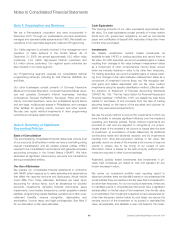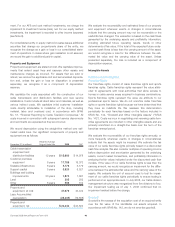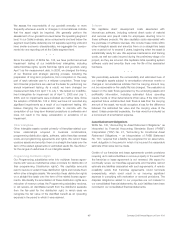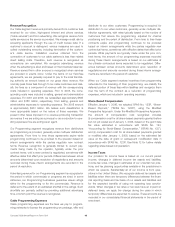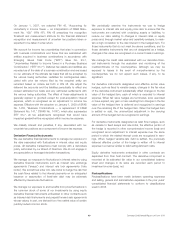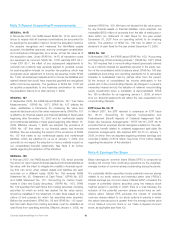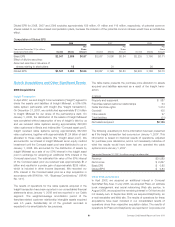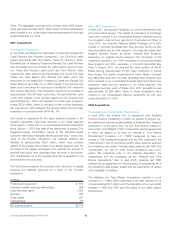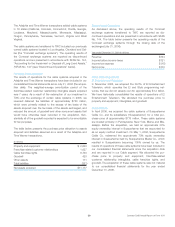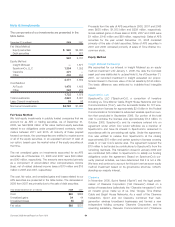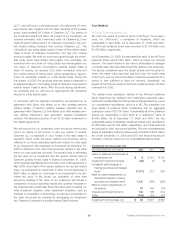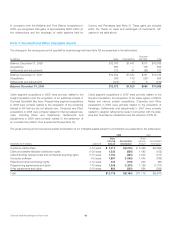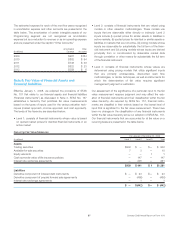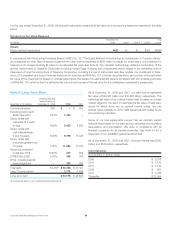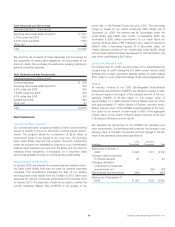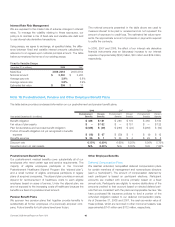Comcast 2008 Annual Report Download - page 52
Download and view the complete annual report
Please find page 52 of the 2008 Comcast annual report below. You can navigate through the pages in the report by either clicking on the pages listed below, or by using the keyword search tool below to find specific information within the annual report.
Note 3: Recent Accounting Pronouncements
SFAS No. 141R
In November 2007, the FASB issued SFAS No. 141R, which con-
tinues to require that all business combinations be accounted for
by applying the acquisition method. Under the acquisition method,
the acquirer recognizes and measures the identifiable assets
acquired, the liabilities assumed, and any contingent consideration
and contractual contingencies, as a whole, at their fair value as of
the acquisition date. Under SFAS No. 141R, all transaction costs
are expensed as incurred. SFAS No. 141R rescinds EITF 93-7.
Under EITF 93-7, the effect of any subsequent adjustments to
uncertain tax positions was generally applied to goodwill, except
for post-acquisition interest on uncertain tax positions, which was
recognized as an adjustment to income tax expense. Under SFAS
No. 141R, all subsequent adjustments to income tax liabilities and
related interest that would have impacted goodwill are recognized
within income tax expense. The guidance in SFAS No. 141R will
be applied prospectively to any business combination for which
the acquisition date is on or after January 1, 2009.
SFAS No. 157
In September 2006, the FASB issued SFAS No. 157, “Fair Value
Measurements,” (“SFAS No. 157”). SFAS No. 157 defines fair
value, establishes a framework for measuring fair value and
expands disclosure about fair value measurements. SFAS No. 157
is effective for financial assets and financial liabilities in fiscal years
beginning after November 15, 2007 and for nonfinancial assets
and nonfinancial liabilities in fiscal years beginning after March 15,
2008. Effective January 1, 2008, we adopted the provisions of
SFAS No. 157 that relate to our financial assets and financial
liabilities. We are evaluating the impact of the provisions of SFAS
No. 157 that relate to our nonfinancial assets and nonfinancial
liabilities, which are effective for us as of January 1, 2009, and
currently do not expect the adoption to have a material impact on
our consolidated financial statements. See Note 8 for further
details regarding the adoption of this standard.
SFAS No. 159
In February 2007, the FASB issued SFAS No. 159, which provides
the option to report certain financial assets and financial liabilities at
fair value, with the intent to mitigate the volatility in financial report-
ing that can occur when related assets and liabilities are each
recorded on a different basis. SFAS No. 159 amends FASB
Statement No. 95, “Statement of Cash Flows,” (“SFAS No. 95”)
and FASB Statement No. 115, “Accounting for Certain Invest-
ments in Debt and Equity Securities,” (“SFAS No. 115”). SFAS
No. 159 specifies that cash flows from trading securities, including
securities for which an entity has elected the fair value option,
should be classified in the statement of cash flows based on the
nature of and purpose for which the securities were acquired.
Before this amendment, SFAS No. 95 and SFAS No. 115 speci-
fied that cash flows from trading securities must be classified as
cash flows from operating activities. Effective January 1, 2008, we
adopted SFAS No. 159. We have not elected the fair value option
for any financial assets or financial liabilities. Upon adoption, we
reclassified $603 million of proceeds from the sale of trading secu-
rities within our statement of cash flows for the year ended
December 31, 2007 from an operating activity to an investing
activity. The adoption of SFAS No. 159 had no effect on our
statement of cash flows for the year ended December 31, 2006.
SFAS No. 160
In November 2007, the FASB issued SFAS No. 160, “Accounting
and Reporting of Noncontrolling Interest,” (“SFAS No. 160”). SFAS
No. 160 requires that a noncontrolling interest (previously referred
to as a minority interest) be separately reported in the equity sec-
tion of the consolidated entity’s balance sheet. SFAS No. 160 also
established accounting and reporting standards for (i) ownership
interests in subsidiaries held by parties other than the parent,
(ii) the amount of consolidated net income attributable to the
parent and to the noncontrolling interest, (iii) changes in a parent’s
ownership interest and (iv) the valuation of retained noncontrolling
equity investments when a subsidiary is deconsolidated. SFAS
No. 160 is effective for us beginning January 1, 2009, at which
time our financial statements will reflect the new presentation for
noncontrolling interests.
EITF Issue No. 06-10
In March 2007, the EITF reached a consensus on EITF Issue
No. 06-10, “Accounting for Deferred Compensation and
Postretirement Benefit Aspects of Collateral Assignment Split-
Dollar Life Insurance Arrangements,” (“EITF 06-10”). EITF 06-10
provides that an employer should recognize a liability for the post-
retirement benefit related to collateral assignment split-dollar life
insurance arrangements. We adopted EITF 06-10 on January 1,
2008, at which time we adjusted beginning retained earnings and
recorded a liability of $132 million. See Note 10 for further details
regarding the adoption of this standard.
Note 4: Earnings Per Share
Basic earnings per common share (“Basic EPS”) is computed by
dividing net income from continuing operations by the weighted-
average number of common shares outstanding during the period.
Our potentially dilutive securities include potential common shares
related to our stock options and restricted share units (“RSUs”).
Diluted earnings per common share (“Diluted EPS”) considers the
impact of potentially dilutive securities using the treasury stock
method except in periods in which there is a loss because the
inclusion of the potential common shares would have an anti-
dilutive effect. Diluted EPS excludes the impact of potential
common shares related to our stock options in periods in which
the option exercise price is greater than the average market price
of our Class A common stock or our Class A Special common
stock, as applicable (see Note 12).
Comcast 2008 Annual Report on Form 10-K 50


